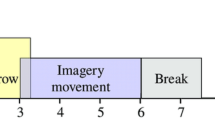Abstract
In order to classify the brain signals of lower limb motor imagery, we used the method of short-time fourier transform (STFT) to transform the signals into time spectrum, and then processed the size and gray scale of the obtained time spectrum. Thus we constructed a neural network model called pragmatic convolutional neural network (pCNN), and the processed 128 * 128 pixel grayscale time spectrums were used as the input for classification. The classification effect was good on all 10 subjects, with the highest accuracy reaching 76\(\%\), while the comparison model was only 66.88\(\%\) (shallow CNN), 52\(\%\) (recurrent CNN) and 68.62 (common spatial pattern + support vector machines). The research results show that STFT is very effective in transforming the EEG input of CNN, and due to the difference of the activated regions between lower limbs and upper limbs, many models with good performance for upper limbs cannot be simply copied to lower limbs.
Access this chapter
Tax calculation will be finalised at checkout
Purchases are for personal use only
Similar content being viewed by others
References
Rao, R.P.N.: Brain-Computer Interfacing: An Introduction, 1st edn., pp. 109–148. Cambridge University Press, Cambridge (2013)
Pfurtscheller, G., Brunner, C., Schlogl, A., et al.: Mu rhythm (de)synchronization and EEG single-trial classification of different motor imagery tasks. Neuroimage 31(1), 153–159 (2006)
Sun, H., Fu, Y., Xiong, X., et al.: Study on EEG pattern recognition based on HHT motor imagery. Acta Automatica Sinica 41(9), 1686–1692 (2015)
Heo, J., Yoon, G.: EEG studies on physical discomforts induced by virtual reality gaming. J. Electr. Eng. Technol. 15(3), 1323–1329 (2020)
Czeszumski, A., Eustergerling, S., Lang, A., et al.: Hyperscanning: a valid method to study neural inter-brain underpinnings of social interaction. Front. Hum. Neurosci. 14, 39 (2020)
Meng, J., Zhang, S., Bekyo, A., et al.: Noninvasive electroencephalogram based control of a robotic arm for reach and grasp tasks. Sci. Rep. 6(1), 38565 (2016)
Stippich, C., Heiland, S., Tronnier, V., et al.: Functional magnetic resonance imaging: physiological background, technical aspects and prerequisites for clinical use. Rofo Fortschr Geb Rontgenstr Neuen Bildgeb Verfahr 174(2), 242 (2002)
Hsu, W., Fong, L., Wei, C., et al.: EEG classification of imaginary lower limb stepping movements based on fuzzy support vector machine with kernel-induced membership function. Int. J. Fuzzy Syst. 19(2), 1–14 (2017)
Padfield, N., Zabalza, J., Zhao, H., et al.: EEG-based brain-computer interfaces using motor-imagery: techniques and challenges. Sensors (Switzerland) 19(6), 1–34 (2019)
Arnaud, D., Scott, M.: EEGLAB: an open source toolbox for analysis of single-trial EEG dynamics including independent component analysis. J. Neurosci. Methods 134(1), 9–21 (2004)
Tayeb, Z., Fedjaev, J., Ghaboosi, N., et al.: Validating deep neural networks for online decoding of motor imagery movements from EEG signals. Sensors 19(210), 1–17 (2019)
Schirrmeister, R.T., Springenberg, J.T., Fiederer, L.D.J., et al.: Deep learning with convolutional neural networks for EEG decoding and visualization. Hum. Brain Mapp. 38(11), 5391–5420 (2017)
Liang, M., Hu, X.: Recurrent convolutional neural network for object recognition. In: Proceedings of the 2015 IEEE Conference on Computer Vision and Pattern Recognition (CVPR), pp. 3367–3375. IEEE Computer Society, Boston (2015)
Ramoser, H., Muller-Gerking, J., Pfurtscheller, G.: Optimal spatial filtering of single trial EEG during imagined hand movement. IEEE Trans. Rehabil. Eng. 8(4), 441–446 (2000)
Acknowledgments
This work was supported by the National Natural Science Foundation of China under Grants 62176054 and 61773114, and the University Synergy Innovation Program of Anhui Province under Grant GXXT-2020-015.
Author information
Authors and Affiliations
Corresponding author
Editor information
Editors and Affiliations
Rights and permissions
Copyright information
© 2021 Springer Nature Switzerland AG
About this paper
Cite this paper
Lu, B., Ge, S., Wang, H. (2021). EEG-Based Classification of Lower Limb Motor Imagery with STFT and CNN. In: Mantoro, T., Lee, M., Ayu, M.A., Wong, K.W., Hidayanto, A.N. (eds) Neural Information Processing. ICONIP 2021. Communications in Computer and Information Science, vol 1517. Springer, Cham. https://doi.org/10.1007/978-3-030-92310-5_46
Download citation
DOI: https://doi.org/10.1007/978-3-030-92310-5_46
Published:
Publisher Name: Springer, Cham
Print ISBN: 978-3-030-92309-9
Online ISBN: 978-3-030-92310-5
eBook Packages: Computer ScienceComputer Science (R0)




